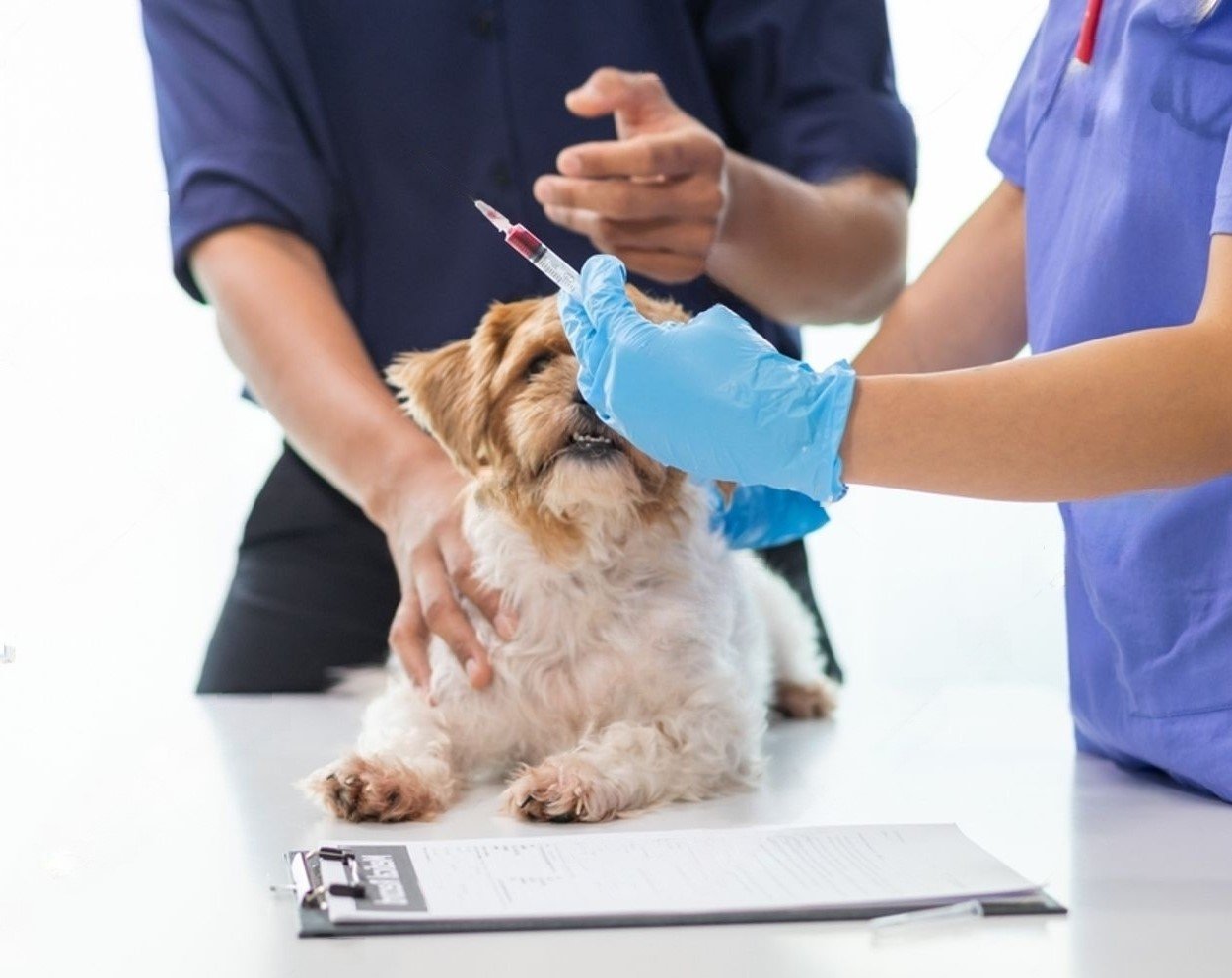What is Rabies?
Rabies is a serious viral disease that attacks the central nervous system in mammals, with dogs being particularly vulnerable. Once a dog is infected, the virus targets the brain and spinal cord, leading to severe symptoms like aggression, behavioral changes, paralysis, and ultimately death. Rabies is nearly always fatal after symptoms emerge, and it poses a significant health threat due to its transmission through saliva, usually via bites, which can also spread to humans.
The virus typically enters through an open wound and travels through the nervous system to the brain, where it causes inflammation, triggering the disease’s characteristic behavioral and physical symptoms. The progression rate depends on the bite’s location and the infected animal’s immune response.
If you’re concerned about how to tell if your dog has rabies, this guide will outline key stages of the disease, warning signs, and why quick action is essential. We’ll also cover the risks to humans and safety measures to protect both you and your pet.
Where Did Rabies Come From?
Rabies isn’t something that was “invented,” but rather a naturally occurring disease that has been around for thousands of years. Historically, rabies has been documented as early as 2300 B.C. in ancient Mesopotamian texts, where they described animals exhibiting rabid behavior. The word “rabies” itself comes from the Latin word rabere, meaning “to rage,” because of the aggression often seen in infected animals.
The understanding of rabies as a viral disease came much later. The major breakthrough occurred in the late 19th century when French scientist Louis Pasteur developed the first rabies vaccine in 1885. Pasteur’s discovery changed the game in the fight against rabies. Before the vaccine, rabies was almost always fatal, not only for animals but also for humans. His development of a rabies vaccine for both animals and humans remains one of the most important medical advancements in preventing this deadly disease.
How to Tell If Your Dog Has Rabies?

Worried your dog might have rabies? It’s a scary thought, but knowing what to look for can help you act quickly. Here are the key signs to watch out for:
Red Flag Behaviors:
- Sudden aggression: Is your usually friendly dog snapping or biting for no reason?
- Restlessness and anxiety: Is your dog pacing, whining, or unable to settle down?
- Unusual affection: Is your dog suddenly overly clingy or seeking attention in an unusual way?
- Unexplained shyness or fear: Has your dog become withdrawn or easily startled?
Physical Warning Signs:
- Fever: Does your dog feel warm to the touch or seem lethargic?
- Loss of appetite: Has your dog stopped eating or shown disinterest in food?
- Excessive drooling: Is your dog drooling more than usual or having trouble swallowing?
- Difficulty walking: Is your dog stumbling, staggering, or unable to move their legs?
- Seizures: Has your dog experienced any seizures or convulsions?
- Has your dog been bitten by a wild animal (like a bat, raccoon, or skunk) or an unvaccinated dog? This is a major risk factor for rabies.
Important Reminders:
It’s crucial to stay vigilant and act quickly if you suspect your dog might have rabies. While it’s important not to panic, any delay could have serious consequences. If you observe any of the warning signs mentioned earlier, especially after a potential bite incident, contact your veterinarian immediately. Remember that these symptoms can be misleading, as they often resemble those of other illnesses. Never attempt to diagnose your dog yourself; always rely on a professional veterinary assessment. While rabies is almost always fatal once symptoms appear, early intervention can be crucial in preventing the spread of the disease to other animals and humans.
How Do Dogs Get Rabies?
Rabies affects dogs by causing a range of symptoms that worsen over time. After a dog is bitten by an infected animal, the virus may remain dormant for weeks or even months, depending on the bite’s location and the dog’s immune system. During this incubation period, there are no visible signs of illness. Once the symptoms manifest, the disease advances quickly.
Initially, infected dogs may show subtle behavioral changes, such as anxiety, restlessness, or aggression. As the disease advances, more serious symptoms develop, including hypersensitivity to sound or light, difficulty swallowing, and foaming at the mouth. In the final stages, the dog may experience paralysis, particularly in the face and throat, and eventually, the virus affects their breathing, leading to death.
Because rabies can spread to humans, it’s crucial to keep dogs up-to-date on vaccinations. If your dog exhibits any unusual behaviors or suffers a bite from a wild animal, seek immediate veterinary attention. Early action can prevent the spread of rabies and save lives.
The Stages of Rabies in Dogs
Rabies progresses in several distinct stages once a dog is infected. Each stage has different symptoms, which worsen as the virus spreads through the body. While the disease is almost always fatal by the time symptoms appear, understanding these stages can help dog owners recognize the signs early and take immediate action.
Incubation Period
The incubation period is the initial phase of rabies, and during this time, the virus is present in the dog’s body but shows no visible symptoms. This phase can last anywhere from a few weeks to several months, depending on the location of the bite and how far the virus has to travel to reach the brain. For instance, if the dog is bitten on a limb, the virus has a longer journey through the nervous system than if the bite is closer to the head.
During this stage, there’s no indication that the dog has rabies, which makes it difficult to detect without knowledge of the bite incident. However, even though symptoms aren’t yet apparent, the virus is actively replicating in the body and preparing to attack the nervous system. This is why prompt action, such as vaccination or observation after a suspected bite, is critical.
Prodromal Stage
Once the virus reaches the brain, the prodromal stage begins, and subtle signs of illness start to appear. This stage typically lasts between 2 to 4 days. Infected dogs may experience behavioral changes, which often go unnoticed at first. For example, a normally friendly dog may become nervous, anxious, or unusually shy. Conversely, a timid dog may act more bold or restless than usual.
Dogs in the prodromal stage might also experience fever, a loss of appetite, and changes in temperament. These early symptoms are easily mistaken for other illnesses, which is why rabies can be tricky to diagnose at this point. However, it’s important to stay alert to any unusual behaviors, especially if your dog has been in contact with wildlife or stray animals.
Furious (Excitative) Stage
The furious stage is the phase most people associate with rabies. This stage, which can last from several hours to a few days, is characterized by aggressive behavior, hyperactivity, and heightened sensitivity to sound, light, and touch. Dogs in this stage may appear restless or irritable, snapping at objects, other animals, or even their owners without warning.
One of the most dangerous aspects of the furious stage is that normally shy or fearful dogs may lose their natural caution, becoming highly aggressive. This poses a significant risk to anyone around the dog, as they are more likely to bite. Rabid dogs may also display erratic behavior, including attempts to chew or bite at imaginary objects, which can be a telltale sign of rabies infection.
In this stage, infected dogs are highly contagious, and extreme caution should be taken to avoid contact with their saliva. It’s crucial to seek immediate veterinary help at this point, but in most cases, the disease has progressed too far to be treated.
Paralytic (Dumb) Stage
The paralytic stage, also known as the “dumb” stage, occurs as the virus progresses, leading to muscle weakness and paralysis. This stage can overlap with the furious stage or follow it. Unlike the aggressive behavior seen earlier, dogs in the paralytic stage become lethargic and eventually unable to move.
This stage typically begins with paralysis in the face and throat muscles, which makes swallowing difficult. Dogs may start drooling excessively, and you may notice foaming around the mouth, not because of anger or aggression, but due to their inability to swallow saliva properly. Muscle weakness and paralysis continue to spread, usually starting at the site of the bite and then moving throughout the body.
As the disease advances, dogs may lose control over their limbs, becoming unable to walk or even stand. At this point, they may also become disoriented and confused, adding to their distress. Rabies progresses quickly, and paralysis usually leads to death within days of entering this stage.
Coma and Death
In the final stage, the dog typically falls into a coma, unable to move, eat, or respond to stimuli. The paralysis worsens, affecting vital functions such as breathing. Without the ability to breathe properly, the dog’s body begins to shut down. Death usually occurs within a few days after the onset of the paralytic stage, often due to respiratory failure.
Because rabies is almost always fatal once symptoms develop, the best course of action is prevention through vaccination. If your dog shows any signs of these stages, it’s crucial to seek immediate veterinary care. Understanding the progression of rabies can help dog owners take swift action, but ultimately, prevention is the key to keeping your pet safe from this deadly virus.
Differentiating Rabies from Other Conditions
Rabies isn’t the only condition that can cause symptoms like aggression, disorientation, or paralysis in dogs. Many other illnesses can mimic rabies, making it challenging to distinguish without professional help. Distemper, for example, can produce symptoms like fever, seizures, and paralysis. Poisoning from specific toxins may lead to neurological issues such as staggering, seizures, and excessive drooling, while epilepsy and even brain tumors can also trigger similar behavioral and neurological symptoms.
This is why self-diagnosis should be avoided. While this article provides useful information about rabies, it’s not a substitute for a professional veterinary examination. Only a vet has the expertise to evaluate your dog’s symptoms, consider their medical history, and conduct tests to rule out other causes. If rabies is suspected, your vet will collaborate with public health authorities to ensure the safety of both animals and humans.
What to Do if You Suspect Rabies

If you suspect that your dog may have been exposed to rabies, it’s critical to act swiftly and cautiously. To ensure the safety of both your pet and yourself, you should follow the steps below:
Avoid Direct Contact: If your dog is showing unusual aggression, drooling excessively, or having difficulty swallowing, avoid close contact. Rabies can spread through saliva, so it’s crucial to prevent bites or scratches.
Isolate Your Dog: Safely confine your dog to an area where they can’t come into contact with other animals or people. This reduces the risk of further exposure and keeps everyone safe.
Call Your Veterinarian Immediately: Contact your vet as soon as possible. They can provide guidance on the next steps, including whether your dog needs to be observed, tested, or quarantined. Time is of the essence with rabies cases.
Report to Local Authorities: Rabies is a public health concern, so notify your local animal control or health department, especially if your dog has been in contact with wildlife or stray animals.
Check Vaccination Records: If your dog’s rabies vaccination is up to date, the situation may be less severe, as vaccinated dogs are better protected. Your vet will advise you on any follow-up actions needed, such as booster shots or observation periods.
Seek Medical Attention for Bites: If you or someone else has been bitten, seek immediate medical attention. Rabies is nearly always fatal once symptoms appear in humans, but post-exposure vaccines can prevent the disease if administered promptly.
Rabies in Humans: What You Should Know
While rabies is rare in vaccinated pets, it can still spread from dogs to humans, especially through bites, scratches, or contact with saliva from an infected animal. Here’s what you need to know about the risk of transmission and treatment options.
Risk of Transmission to Humans
The rabies virus is mainly spread through the saliva of an infected animal, typically when it bites another animal or a human. If a rabid dog bites or scratches you, or if their saliva gets into an open wound or mucous membranes (eyes, mouth), there’s a risk of infection. Early symptoms in humans are similar to the flu—fever, headache, and fatigue—but as the virus progresses, it affects the central nervous system, leading to confusion, agitation, paralysis, and eventually death if untreated.
If you’ve been bitten or exposed to a potentially rabid animal, immediate action is critical. Wash the wound thoroughly with soap and water, and seek medical attention right away. Your doctor will determine if rabies is a risk based on the bite and the animal’s behavior.
Post-Exposure Prophylaxis (PEP)
Post-Exposure Prophylaxis (PEP) is the treatment available for humans who have been exposed to rabies. PEP involves a series of rabies vaccines that are most effective when administered soon after exposure—ideally within 24 hours. This treatment helps prevent the virus from spreading through your body, stopping the infection before symptoms develop. Once symptoms appear, rabies is almost always fatal, so early intervention with PEP is essential.
Conclusion
Rabies is a deadly disease, but by staying informed and vigilant, you can protect your dog and yourself. Awareness of the symptoms and stages of rabies, along with timely action, can make all the difference. Early detection is key to keeping your pet safe, and prevention through regular vaccinations is the most effective way to stop rabies in its tracks.
If you notice any unusual behavior in your dog—whether it’s aggression, disorientation, or drooling—don’t hesitate to consult your veterinarian immediately. A professional can diagnose and guide you through the necessary steps to ensure your dog’s health and safety.
Remember, vaccinating your dog regularly is not only a legal requirement in many places, but it’s also your pet’s best defense against rabies. Share this article with other pet owners to spread awareness, follow preventive measures, and double-check that your dog’s rabies shots are up to date. Prevention is the best protection!
FAQ’s
What are the telltale signs of rabies in dogs?
While rabies can mimic other illnesses, some common signs include sudden aggression, restlessness, unusual affection or shyness, fever, loss of appetite, excessive drooling, difficulty swallowing, staggering, paralysis, and seizures. Any of these symptoms, especially after a potential bite from a wild or unvaccinated animal, warrant immediate veterinary attention.
Can my dog get rabies even if they are vaccinated?
While rabies vaccination is highly effective, no vaccine is 100% foolproof. However, if a vaccinated dog is exposed to rabies, it’s much less likely to develop the disease. Your veterinarian may recommend a booster shot in such cases.
Can I get rabies from my dog even if they don’t bite me?
While bites are the most common route of transmission, rabies can also spread through scratches, open wounds, or contact with infected saliva. It’s crucial to avoid contact with a dog’s saliva if you suspect they may have rabies.
Can rabies be cured in dogs?
Sadly, once rabies symptoms manifest, there’s no effective treatment to reverse the disease’s progression. The disease is almost always fatal. This is why prevention through vaccination is so critical.
How long does it take for rabies symptoms to show up in dogs?
The incubation period (time between exposure and symptoms) can vary greatly, from a few weeks to several months. It depends on factors like the location of the bite and the dog’s immune system.
What is the treatment for rabies in humans?
There is no cure for rabies once symptoms appear in humans. However, post-exposure prophylaxis (PEP), a series of injections, is highly effective in preventing the disease if administered promptly after exposure.







